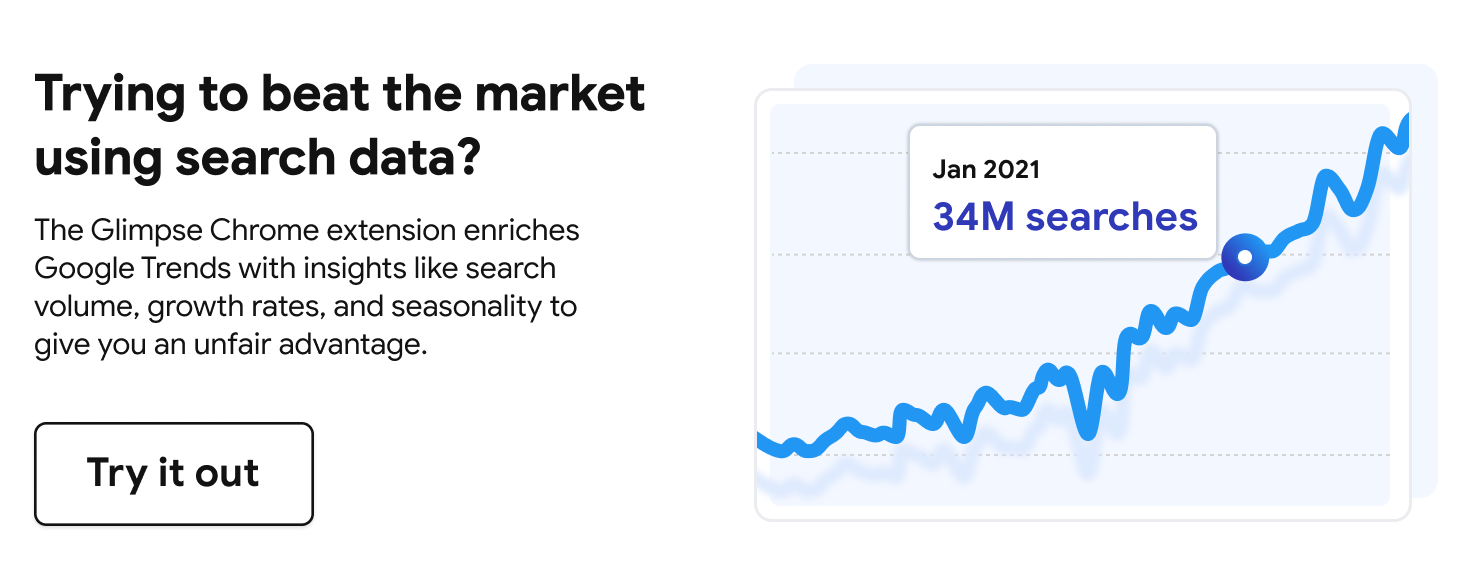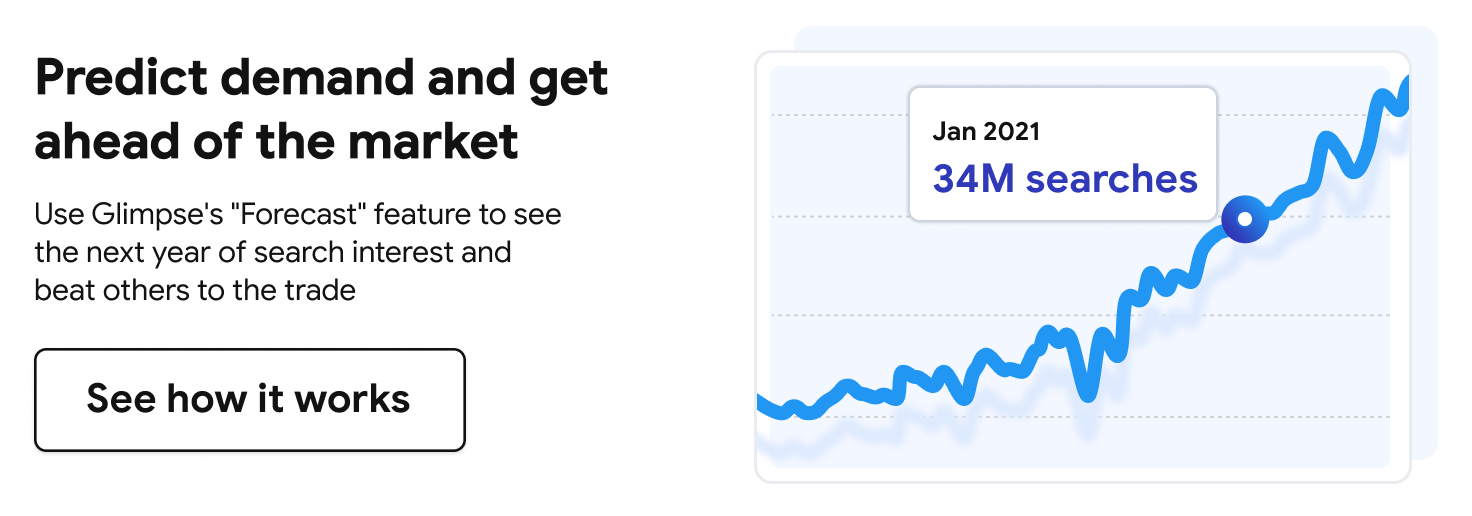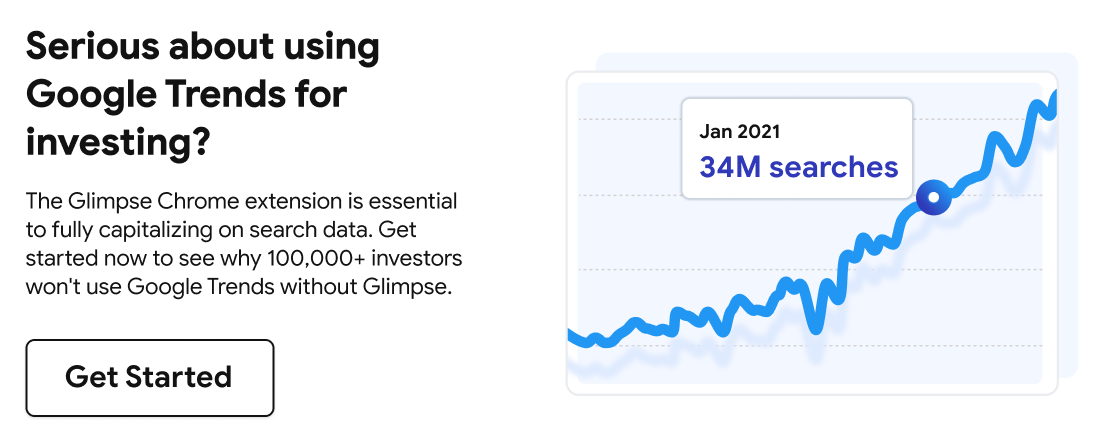Did you know that Google searches can predict a company's revenue better than it's stock price?
Google Trends is one of the most powerful and under-the-radar tools for stock market trading and investing, providing unique insights into consumer behavior with both historical and real-time search interest in any keyword.
In this guide, we'll share 9 unique strategies to find alpha using Google Trends. Let’s get started.
(If you aren't familiar with Google Trends, get up-to-speed first.)

Strategy #1: Estimate revenue in real-time
The first trading strategy is to use Google Trends to estimate a company’s revenue before they release it in their quarterly earnings, giving you a first-mover advantage.
For example, suppose you're interested in American Airlines. You'll first need to choose a search query that might be correlated to revenue, like "American Airlines flights to", then download the Google Trends data and overlay it with quarterly revenue to gauge the correlation.

Looking at the graph, you'll see that the two are indeed correlated. In fact, American Airlines' revenue during this period is more strongly correlated with searches for this phrase than its own stock price (R-value of 0.764 vs. -0.293).
Try it yourself: Find a keyword or phrase that has a high correlation to a company's earnings, then use it as an early indicator for trading decisions.

Strategy #2: Spot mispricings
Google Trends data can be used to spot mispricings by comparing stock prices to interest levels.
For example, imagine it’s mid-May, 2020, and the entire travel industry has been decimated by COVID. Airline and hospitality stocks have plummeted as nobody can foresee demand returning anytime soon.
And yet, if you use Google Trends to download the raw data for search interest in "flights to", then compare it against airline stock prices, you'll see there’s some mispricing amiss.
Here’s the price history of top airline stocks (blue) vs. search interest in flights (orange):

For 3 weeks, from the end of April through mid May, airline stocks continue to fall while flight interest steadily increases.
Seeing this, you decide that the market is bound to reprice airlines to match the recovery in demand for flights, and purchase shares just in time to catch the 100%+ spike a week later:

Try it yourself: Compare industry stock prices against high-intent Google Trends data to spot mispricing opportunities.
Strategy #3: Measure hype to time market entry
While many investments rely on financial analysis, others—like crypto, NFTs, penny stocks, high-growth tech stocks, etc.—are driven mainly by speculation. This is even more true now than it was a decade or two ago as finance influencers direct crowds of millions on a whim.
If you choose to play this game, then the least you can do is minimize your chances of entering at the peak of the hysteria by using Google Trends' search interest as an indicator of market hype and avoid buying at the worst time.
For instance, in December 2020, Bitcoin hit new highs, along with searches for ‘buy bitcoin,’ suggesting a largely FOMO-driven surge filled with traders who will likely sell at the first hint of a drop, amplifying a crash.
Conversely, in February 2023, Bitcoin climbs steadily while searches remain low, suggesting that existing holders are calmly adding to their portfolios. Eventually, searches jump again (though nothing in comparison to 2020), leading prices to climb and remain near all-time-highs.

Google Trends is a key tool in spotting peak hype and can reduce your risk considerably when trading speculatory assets.
Try it yourself: Check the current search interest in your target asset the next time you’re considering an entry to measure hype and avoid poor market timing.
Strategy #4: Measure and track cultural shifts
The next Google Trends trading strategy is to track the status of a cultural shift to help decide whether or not you want exposure to a particular industry.
For example, if you’re looking at investing in meat alternatives, you can view the interest over time for queries like “is meat healthy” to determine whether or not consumers are growing more or less concerned about their meat consumption.

In this case, you'll see a consistent rise in searches, indicating that meat alternatives will likely benefit from the increased concern for meat’s health-related side effects.
Learn more about pulling insights from Google Trends' interest over time.
Try it yourself: Explore the status of a cultural shift by searching keywords that represent interest in it.
Strategy #5: Spot micro trends to get ahead of macro shifts
Google search data can also be used to discover early investment opportunities. Since all cultural, macro shifts emerge from the clustering of specific, micro trends, if you can spot the micro trends early, you’ll have an advantage in spotting related opportunities in the macro shift.
For example, imagine it’s 2012. People are starting to hear about Uber, but the macro “sharing economy” trend is still only known to a handful of people. If you hear about Uber via news articles on the rise of the sharing economy, you're already far too late.

Instead, if you spot Uber's rise, you might look for other early opportunities to invest in the emerging "sharing economy," such as Doordash, which took off shortly after.

Limitations of Google Trends
While Google Trends is useful in researching these companies after you hear about them, it doesn't recommend which companies to investigate in the first place.
Glimpse, an extension that enhances Google Trends, solves this by tracking every significant keyword searched online and alerting you when a term like Uber starts to take off in popularity. This means you can systematically spot new trends right when they emerge and act before anyone else.
For example, Glimpse spotted and published content about the rise of pickleball in 2019, before it grew more than 800% in popularity. Had you known about this trend then, you could have made investments in retailers like Dick’s Sporting Goods (up 400% since 2019) to capitalize on the growing interest before it became the cultural phenomenon it is today.
While the focus of this guide is on Google Trends, we’ll reference Glimpse where relevant to highlight additional insights.
Try it yourself: Sign up for a free Glimpse account to start spotting micro trends and get ahead of the curve.
Strategy #6: Measure and track consumer sentiment
Next, Google Trends can give insight into consumer sentiment towards a brand, which can then inform investment decisions.
Suppose you’re considering investing in United Airlines. Beyond standard financial analysis, you want to understand how consumers perceive the company. Google Trends can help by revealing queries that indicate skepticism.
To find relevant queries, just type ‘is United Airlines’ into Google and see what auto-complete options pop up.

The top two reflect consumer skepticism and, if searched on Google Trends, show considerable growth over the past few years:

This suggests that certain events may have damaged public perception of United Airlines, something that you likely wouldn't spot in a purely financial analysis.
The Glimpse extension streamlines this process with a People Also Search panel, which shows the most common questions related to any search term, sorted by search volume.

However, before drawing any conclusions on United Airlines, it’s worth determining if this skepticism is unique to the company or is a broader issue for all airlines.
To find out, just remove ‘United’ from your search.

Looks like the airline industry as a whole is facing increased skepticism around safety and quality.
You can perform this same analysis on any company or industry by adjusting the suffixes to fit the context. For example:
Transportation: “safe”, “reliable”
Tech: “private”, “safe for kids”
Food: “healthy”, “unhealthy”, “good for you”
Banking: “trustworthy”, “good”, “FDIC insured”
Try it yourself: Measure trajectories of the top concerns for your chosen company to determine if they are increasing or decreasing.
Strategy #7: Use seasonality to understand consumer behavior
Next, you can use Google Trends to measure seasonality and more deeply understand consumer behavior. While it’s obvious why demand for Christmas trees peaks in December, many other topics follow less-obvious seasonal trends.
For example, search interest in ‘Google Docs’ varies throughout the year. See if you can tell what the pattern is in the graph below:

If you look closely, you'll see recurring spikes in spring/fall and dips in summer/winter, meaning that education and the school calendar drive a lot of interest. This can inform any projections of Google Docs’ future performance and better time trading decisions.

While it’s possible to identify this pattern just by looking at the Google Trends trajectory, it’s not easy, and since seasonality is crucial for understanding a product or service, Glimpse includes a dedicated panel that provides a simple visualization of seasonality, along with an explanation for what drives it.

Additionally, because seasonal variations can make it difficult to identify the overall trajectory, Glimpse adds a seasonally-adjusted trendline, growth calculation, and 12-month forecast.

While the tool’s forecast accuracy is over 87%, deviations are certainly possible. Nonetheless, you can be reasonably confident that, barring any major events, search activity in Google Docs will continue to decline over the next year. This doesn’t always mean that usage of Google Docs will decline but it does offer a unique view into public interest in the product.
Try it yourself: Search a variety of company-specific keywords and determine their seasonality to better understand the consumer behavior that drives demand.
Strategy #8: Measure shifts in market share
Next, since search interest largely represents demand, you can use Google Trends to measure shifts in competitors' market shares.
For example, comparing Grubhub against Uber Eats and DoorDash, you'll see that Grubhub initially led the food delivery space, but was eventually surpassed by both.

Additionally, building on the consumer sentiment analysis covered earlier, you can compare how well different products or companies address common concerns, such as privacy across web browsers:

Learn more about comparing terms in Google Trends.
Try it yourself: Compare search interest in competitors, either at the company or product level, to track shifts in market share.
Strategy #9: Gauge the impact of PR
Lastly, you can use Google Trends to gauge the impact of PR. First, you can see how well a company can capture the public's attention with its events.
For example, searching "Tesla event" shows that peak interest occurred in November 2017 when the company revealed its semi-truck and 2nd-generation roadster, with subsequent events only reaching a maximum of 75% of this interest.

Next, you can measure the success of a product launch.
Tesla's Cybertruck, for example, was announced in 2020, then launched in 2024. Searching Google Trends and setting location to the US shows that the announcement generated the most interest, with the post-launch reaching roughly half of that peak before falling off.

Lastly, you can measure the impact of bad press.
In Tesla’s case, despite continual growth, there have been recurring headlines covering crashes involving a Tesla, especially regarding its self-driving capabilities.
For over a decade, Google searches for “is Tesla safe” followed the trend of interest in the company as a whole. However, this has now shifted, and there is growing concern for the cars’ safety without a growth of interest in the company itself:

This might imply increased concern about buying Tesla vehicles which could affect future sales and market confidence.
Try it yourself: Search for a company’s PR events to gauge their ability to capture attention, as well as any related searches that represent consumer perceptions.
In so many ways, Google Trends offers stock market traders and investors an unparalleled opportunity to find alpha.
